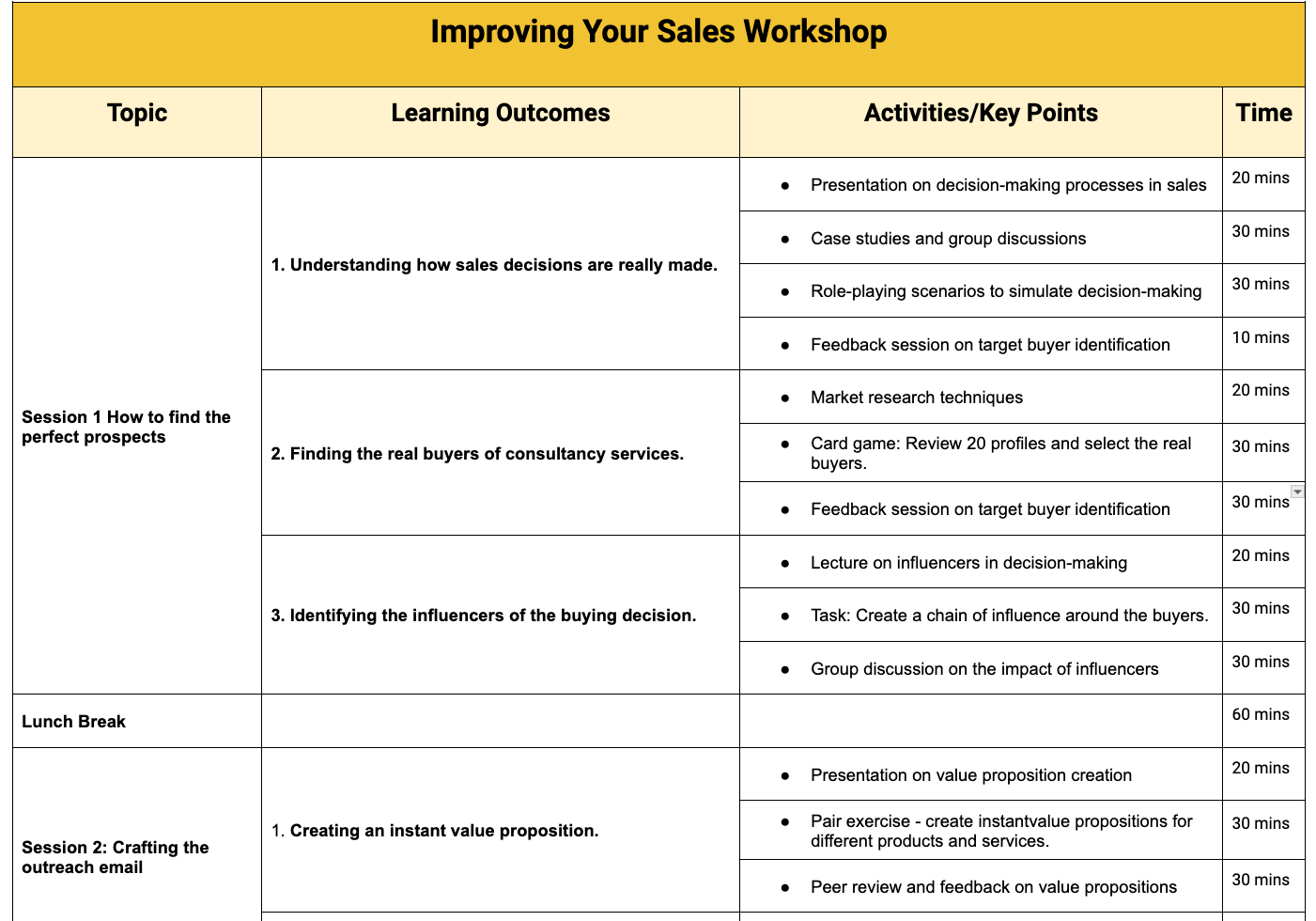Hi, I’m Rich. Welcome to my weekly newsletter where I share systems and frameworks for scaling your consulting practice from $0 to $1m+ in revenue.
You can get 1:1 personal coaching or explore my course: Proposal Mastery: Learn To Write Winning Business Proposals.
A while back, I taught a workshop that didn’t go as well as I had expected.
It was a two-day workshop. But after the first day, I received a call in the evening from my client with the following feedback:
The workshop feels a little rushed.
I want you to share more of your expertise.
Let’s go through the slides for tomorrow and see what we can cut out.
I was not allowing enough time for useful, but off-topic, discussions between audiences
We needed more breaks during the day [this contradicts the above]
Making changes to the workshop at 9 pm halfway through is a sign that something has gone wrong.
Constant Clarification Doesn’t Always Work
I had followed the critical principle of constant clarification.
We had agreed on the project about two months previously and set some clear learning objectives. I was following my typical workshop development process. I sent through the learning objectives and the number of sessions, and the title of those sessions. This was baked into our contract, which they agreed to largely without any question.
About a month out, I sent through a fully fleshed-out agenda detailing every activity that would match those objectives. You can see an example below.
p.s. You can: Download our workshop template agenda here
The client approved our agenda, again without providing any significant feedback, aside from confirming the times.
Then, in the two weeks prior to the workshop, I prepared the slides for the six sessions and sent them through (with a day or two between each set, not to overwhelm).
I didn’t hear back from the client during this phase, except to confirm the schedule. This should have sent some alarm bells ringing, but it didn’t.
Even on arrival, things seemed slightly off. The client didn’t greet me; I had to find the meeting room myself. When I did, no one was there, etc…
People showed up, and I delivered the sessions. But I occasionally felt we were covering material that wasn’t completely aligned with their needs. And the critical stakeholder had to leave at one point, so I had to readjust the schedule on the fly, which meant working through lunch. Not ideal.
Not Getting Feedback Is A Big Red Flag
A lack of good feedback is a terrible sign.
It’s a sign the client either doesn’t care about the project (oh dear!) or hasn’t had the time to really look at what I’m sending through.
In my case, the client (or my contact) had been through a busy spell and had not had the time to review the materials carefully. It was easier for her to say yes and approve things to avoid being a blocker.
The client had trusted me to take a few documents and calls and spin that out into a complete two-day workshop without much input from them.
But that’s an unrealistic expectation. It’s like approving the blueprints for a house without looking at them, and then being disappointed when the finished home isn’t laid out how you imagined.
Either way, now we find ourselves in a situation where no one is happy.
So, who is to blame?
It’s Easy To Blame The Client
It’s easy to blame the client in these situations. They approved everything and had all the time they needed to provide feedback in advance. And that was my initial reaction - if they had given me better feedback, they would have achieved better results.
But the more I thought about it, the more I realised I had dropped the ball.
I knew, deep down, that not getting good feedback was a bad sign. But it’s also true that they can’t be upset about someone delivering the very material they had approved.
But the reality is more complex than this. I believe it’s important to recognise three things.
It’s always a bad idea to blame the client. It eliminates any chance of a long-term relationship and avoids any personal reflection. That means no testimonials or case studies.
You’re paid for the outcome, but held accountable for the deliverables. There is a lot you have to do to deliver a successful outcome, which isn’t always within the confines of the deliverables. This was one of those times.
If you could have done more, you should have done more. Within a few limits, if you can do more to help clients, you should do more. There were things within my influence (we’ll get to that later) that could have helped.
Sometimes, You Just Need To Shout Louder
It feels a lot easier when clients approve things.
You don’t need to go back and make revisions/adjustments. The work proceeds faster. And yet, if the client isn’t happy with the end result, does any of it matter?
They won’t hire you again, refer you to others, nor give you a testimonial and case study - all the things you need to grow.
On reflection, it’s pretty clear what I should have done.
This is one of those situations where I needed to insist on feedback. I needed to pester them and make this project a priority. I don’t want acquiescence, I want collaboration. I need to demand their feedback and ideas.
I should have demanded calls to go through things and asked specific questions that required an answer and a careful review of the material.
But knowing what I should have done is different from ensuring I change in the future.
Which is why we turn moments of failure into part of a new system.
Turn It Into A System
Based on this incident, I’ve created a new system where I embed a pre-workshop review session of 60 to 90 minutes a week beforehand to make sure everything is perfectly aligned to what the client needs.
I make it a contractual requirement of both sides to attend this, or the workshop will not proceed (and I still get paid). Once the project is signed and the date is confirmed, a date for the review is confirmed too. It’s updated in the template SOW I have for workshops and my project plans for the workshop (always update your templates for lasting change).
Sure, this review session is additional work for me. But my goal isn’t just to deliver the project; it’s to ensure the client gets the best outcome. Because the better the outcome for the client (besides just feeling good), the better the outcome for me, too.
And that’s the real lesson from this. It’s very easy to have a project that didn’t go to plan, identify the issue, and try to do better in the future. But it’s a lot more effective to identify where you can ensure things will be different in the future and make the change you need to make.
Learn from your mistakes and incorporate them into your improved system for future reference.
Good luck!
Connect with Rich
Are you new to the newsletter? Subscribe for free
Follow me on LinkedIn for more insights
Learn to write persuasive business proposals with my Proposal Mastery course.
Get 1 to 1 personal coaching. Get a personal coach to help you grow your consultancy practice. Tackle topics like positioning, client acquisition, delivering exceptional value, industry leadership, and building the systems to thrive. Hit reply or learn more about my coaching approach.





